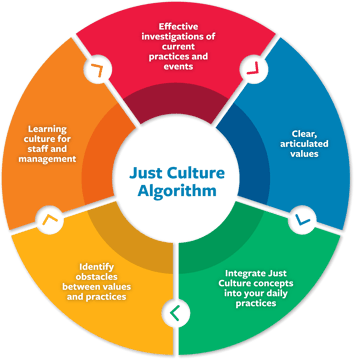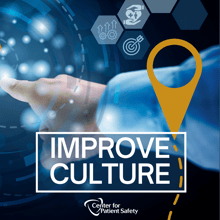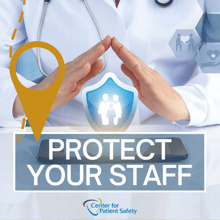“Culture,” in its simplest form, consists of the attitudes, beliefs, and perceptions of a collective group of people. It shapes their behaviors, decisions, and choices and is, therefore, a complicated but highly influential component of the safety equation.
Individual agencies tend to develop their own subcultures; and this can result from a distance, unique shared experiences, or just variations in management style. Unfortunately, these variations can lead to the breakdown of the organization’s overall mission, vision, and values that can lead to medical errors.
Does your staff fear they will be punished for mistakes? Or do they believe your organization will fairly evaluate your systems and treat staff justly?
Patient and provider safety is important, but how do we establish a culture that encourages open reporting of adverse events and risky situations, yet holds people accountable in a just manner? The challenge lies in distinguishing between a system that might create risks, or human error which may result in a bad outcome, and reckless behavior that intentionally puts lives or organizations at risk.
The Center for Patient Safety is able to customize education for your leaders and staff after a culture assessment that is specifically designed for your organization based on the results from your assessment.
Culture change is a transformative process. Just as sailors would not begin a voyage without a map and navigation tools, culture change requires planning and direction.
It’s estimated between 250,000 and 440,000 patients in the U.S. die every year from medical errors. The wide margins are mostly due to not having a reliable way to measure all deaths that tie back to a medical error, so we must rely on estimates. The exact number is not as important as the people being harmed and dying of medical errors. We have the resources to reduce those numbers! Check out our offerings below for more information on educational opportunities.
As you continue on your journey, participating with a PSO can help. Many states around the nation do not provide adequate confidentiality, or peer review protections for EMS services and providers. A solution to overcome this barrier comes to you via participation with a Patient Safety Organization (PSO). As a PSO, the Center for Patient Safety offers federal-based confidentiality protection for your safety and quality improvement work.
“EMS agencies can become members of PSOs and not only achieve protection of their own processes but also benefit from the collective knowledge and understanding provided by the PSO and its members.” – The National Association of Emergency Medical Technicians (NAEMT)
Key PSO Points:



The links between organizational culture, safety, and quality are nothing new. Many industries have generated high-reliability outcomes by addressing culture change. Having a benchmark that leaders can use to provide perspective on the health of their safety culture is a valuable component of improving culture.
The Center for Patient Safety seeks to improve deficits through the use of an assessment process that includes a survey with a quantifiable snapshot in time of your safety culture. The snapshot allows you to:
The Center for Patient Safety has developed the ONLY Culture Survey specifically customized for First Responders that aligns with the surveys designed by AHRQ for other areas in healthcare.
Before training begins, the Center will:
The training:
CPS works with clients to develop meaningful follow-up programs to support the implementation.
Option A: Fully online/virtual OR Option B: In-person
PHASE 1 - EXECUTIVE WEBINAR
This one-hour webinar will introduce leaders to key concepts of just culture/shared accountability in the context of their leadership role. At least one senior leader in each participating organization must attend this program which will deepen their understanding of key principles and their critical role in the success of the program. It will also describe the multi-faceted benefits of robust just culture/shared accountability implementation
PHASE 2 - ONLINE JUST CULTURE TRAINING
The training for managers and supervisors can be provided either online by CPS or via The Just Culture Company’s online courses.
PHASE 3 – COLLABORATIVE LEARNING
Six 30-minute monthly webinars will be offered to assist participants with learning and just culture implementation.
Topics In Past Collaboratives Included:
The collaborative also offers:

Today's healthcare workforce is facing a multitude of challenges. Most health care providers adjust well to the multitude of demands encountered during a traumatic clinical event or challenging times. Providers often have strong emotional defenses that carry them through and let them “get the job done.” Yet sometimes the emotional aftershock (or stress reaction) can be difficult. Signs and symptoms of this emotional aftershock may last a few days, a few weeks, a few months, or longer.
Our team is happy to respond to requests for more information. Simply provide us with a few details about the challenge you're experiencing, or what program(s) you think would be helpful, and we'll prepare a plan that fits your needs.

“The culture of an organization will either deter or drive the organization’s ability to accomplish its mission. In EMS we discuss safety in our leadership huddles, attend safety seminars and safety presentations at conferences, but the most profound insight into our culture of safety can be achieved through introspection. At Cox Health EMS, our use of the EMS patient safety culture survey has been crucial in understanding how our staff view safety and our efforts to improve it. The information learned has been invaluable to our ability to enhance the safety of our organization for staff and patients.”
Mark Alexander CoxHealth EMS
400 Chesterfield, Ste #400, Chesterfield MO 63017 573-636-1014